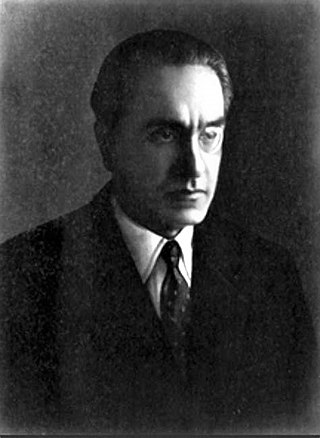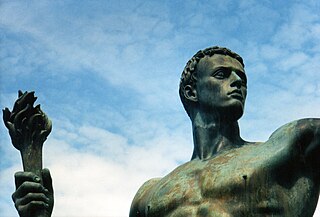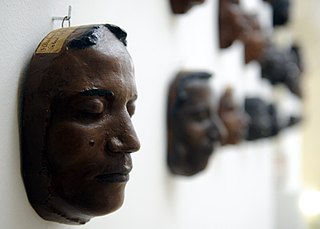
Giulio Cesare Andrea "Julius" Evola was an Italian far-right philosopher. Evola regarded his values as aristocratic, monarchist, masculine, traditionalist, heroic, and defiantly reactionary. An eccentric thinker in Fascist Italy, he also had ties to Nazi Germany; in the post-war era, he was an ideological mentor of the Italian neo-fascist and militant Right.

Aryanism is an ideology of racial supremacy which views the supposed Aryan race as a distinct and superior racial group which is entitled to rule the rest of humanity. Initially promoted by racist theorists such as Arthur de Gobineau and Houston Stewart Chamberlain, Aryanism reached its peak of influence in Nazi Germany. In the 1930s and 40s, the regime applied the ideology with full force, sparking World War II with the 1939 invasion of Poland in pursuit of Lebensraum, or living space, for the Aryan people. The racial policies which were implemented by the Nazis during the 1930s came to a head during their conquest of Europe and the Soviet Union, culminating in the industrial mass murder of six million Jews and eleven million other victims in what is now known as the Holocaust.

The "Manifesto of Race", otherwise referred to as the Charter of Race or the Racial Manifesto, was a manifesto which was promulgated by the Council of Ministers on the 14th of July 1938, its promulgation was followed by the enactment, in October 1938, of the Racial Laws in Fascist Italy (1922–1943) and the Italian colonial empire (1923–1947).
This is a list of topics related to racism:

The Manifesto of the Anti-Fascist Intellectuals, written by Benedetto Croce in response to the Manifesto of the Fascist Intellectuals by Giovanni Gentile, sanctioned the irreconcilable split between the philosopher and the Fascist government of Benito Mussolini, to which he had previously given a vote of confidence on 31 October 1922. The idea of an anti-Fascist manifesto came to Giovanni Amendola, who wrote to Croce, a proclaimed anti-Fascist, for his opinions on 20 April 1925:
Dear Croce, have you read the Fascist manifesto to foreign intellectuals? ... today, I have met several people who feel that, following the publication of the Fascists' document, we have the right to speak and the duty to respond. What is your opinion? Would you be willing to sign such a document, or even write it yourself?

Ettore Ovazza was an Italian Jewish banker. He was an early financer of Benito Mussolini, of whom he was a personal friend, and Italian fascism, which he supported until the Italian racial laws of 1938. He founded the journal La nostra bandiera. Believing that his position would be restored after the war, Ovazza stayed on after the Germans marched into Italy. Together with his wife and children, shortly after the Fall of Fascism and Mussolini's government during World War II, he was executed near the Swiss border by SS troops in 1943.

The Italian racial laws, otherwise referred to as the Racial Laws, were a series of laws which were promulgated by the Mussolini government in Fascist Italy (1922–1943) from 1938 to 1943 in order to enforce racial discrimination and segregation in the Kingdom of Italy. The main victims of the Racial Laws were Italian Jews and the native African inhabitants of the Italian colonial empire (1923–1947). In the aftermath of Mussolini's fall from power, the Badoglio government suppressed the laws. They remained enforced and were made more severe in the territories ruled by the Italian Social Republic (1943–1945) until the end of the Second World War.

Giovanni Preziosi was an Italian fascist politician noted for his contributions to Fascist Italy.

The Sammarinese Fascist Party or PFS was a fascist political party that ruled San Marino from 1923 to 1943.

Telesio Interlandi was an Italian journalist and propagandist. He was one of the leading advocates of antisemitism in Fascist Italy.

Racism in Italy deals with the relationship between Italians and other populations of different ethnicities and/or nationalities which has existed throughout the country's history.
This is a list of words, terms, concepts, and slogans in the Italian language and Latin language which were specifically used in Fascist Italian monarchy and Italian Social Republic.

The Ministry of Popular Culture was a ministry of the Italian government from 1937 to 1944.

Initially, Fascist Italy did not enact comprehensive racist policies like those policies which were enacted by its World War II Axis partner Nazi Germany. Italy's National Fascist Party leader, Benito Mussolini, expressed different views on the subject of race over the course of his career. In an interview conducted in 1932 at the Palazzo di Venezia in Rome, he said "Race? It is a feeling, not a reality: ninety-five percent, at least, is a feeling. Nothing will ever make me believe that biologically pure races can be shown to exist today". By 1938, however, he began to actively support racist policies in the Italian Fascist regime, as evidenced by his endorsement of the "Manifesto of Race", the seventh point of which stated that "it is time that Italians proclaim themselves to be openly racist", although Mussolini said that the Manifesto was endorsed "entirely for political reasons", in deference to Nazi German wishes. The "Manifesto of Race", which was published on 14 July 1938, paved the way for the enactment of the Racial Laws. Leading members of the National Fascist Party (PNF), such as Dino Grandi and Italo Balbo, reportedly opposed the Racial Laws. Balbo, in particular, regarded antisemitism as having nothing to do with fascism and he staunchly opposed the antisemitic laws. After 1938, discrimination and persecution intensified and became an increasingly important hallmark of Italian Fascist ideology and policies. Nevertheless, Mussolini and the Italian military did not consistently apply the laws adopted in the Manifesto of Race. In 1943, Mussolini expressed regret for the endorsement, saying that it could've been avoided. After the Second Italo-Ethiopian War, the Italian Fascist government implemented strict racial segregation between white people and black people in Ethiopia.
Edoardo Zavattari was an Italian zoologist who was a director at the Institute of Zoology in the Sapienza University of Rome from 1935 to 1953. He supported fascism and antisemitism on the basis of his ideas from biology and was a signatory to the "Manifesto della Razza".
Fascist mysticism was a current of political and religious thought in Fascist Italy, based on Fideism, a belief that faith existed without reason, and that Fascism should be based on a mythology and spiritual mysticism. A School of Fascist Mysticism was founded in Milan on April 10, 1930, and active until 1943, and its main objective was the training of future Fascist leaders, indoctrinated in the study of various Fascist intellectuals who tried to abandon the purely political to create a spiritual understanding of Fascism. Fascist mysticism in Italy developed through the work of Niccolò Giani with the decisive support of Arnaldo Mussolini.
Giulio Cogni was an Italian writer, racial theorist, music composer and music critic.

The Kingdom of Italy was governed by the National Fascist Party from 1922 to 1943 with Benito Mussolini as prime minister and dictator. The Italian Fascists imposed totalitarian rule and crushed political and intellectual opposition, while promoting economic modernization, traditional social values and a rapprochement with the Roman Catholic Church.

Lidio Cipriani was an anthropologist, university teacher and explorer from Florence.
Il Tevere was a Fascist newspaper which was published in Rome, Kingdom of Italy, between 1924 and 1943. It is known for its founder, Benito Mussolini.











